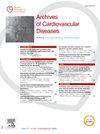Valves in pulmonary veins: New approach for the heterotopic treatment of mitral regurgitation
IF 2.3
3区 医学
Q2 CARDIAC & CARDIOVASCULAR SYSTEMS
引用次数: 0
Abstract
Introduction
Severe mitral regurgitation (MR) can be surgically addressed when the operative risk is considered acceptable. If not, several percutaneous approaches have been developed, including percutaneous mitral valve replacement and edge-to-edge repair. However, there is still an unmet need for a procedure to manage patients who are too frail for cardiac surgery and for whom current percutaneous options are contraindicated or have failed. We hypothesized that the implantation of percutaneous valves within the pulmonary veins (PV) could protect the patient from the consequences of a severe MR.
Objective
To design a synthetic valve that can be implanted in PVs for the heterotopic treatment of severe MR and test its performance in restoring cardiac output (CO) in a phantom model.
Method
An innovative process to produce customizable synthetic prosthetic valves was developed: molds of a valve prosthesis designed to be inserted in a PV were 3D-printed and used to produce prostheses made of polyvinyl alcohol hydrogel. Subsequently, in vitro tests have been conducted to evaluate the performance of the prosthetic valves under physiological conditions. The phantom includes 6 main components mimicking a left atrium (LA) with 3 PVs, a 5 mm diameter orifice as depressurization system (DS), an anatomically correct mitral valve, a dynamic left ventricle, an aortic valve, and an aorta (Figure 1). The coaptation of the mitral valve leaflets was adjusted to simulate levels of MR. Four different conditions were tested three times each: 1) No MR, no valve in PVs and DS closed (control position); 2) Severe MR, no valve in PVs and DS closed; 3) Severe MR, valves inserted in each PV and DS closed; 4) Severe MR, valves inserted in each PV and DS open to mitigate a rise in LA pressure (LAP). Forward cardiac output (CO) and mean LAP were assessed.
Results
In the control condition mimicking a healthy subject, the CO was 3.96 ± 0.05 L/min and the mean LAP was 2.8 ± 1.2 mmHg. When severe MR was induced (condition 2), the CO dropped to 2.16 ± 0.16 L/min and the mean LAP increased to 4.0 ± 1.1 mmHg. Once prosthetic valves were added in the PVs (condition 3), the CO rose up to 3.37 ± 0.33 L/min and the mean LAP up to 31.7 ± 1.3 mmHg. With the DS opening (condition 4), the mean LAP dropped to 22.9 ± 1.5 mmHg with a slight reduction in CO (2.98 ± 0.04 L/min).
Conclusion
This proof-of-concept study successfully demonstrates that implantation of valves in PVs can restore CO in presence of severe MR and that a DS can mitigate the resulting rise in LAP.
肺静脉瓣膜:异位治疗二尖瓣反流的新途径
在手术风险可接受的情况下,严重的二尖瓣反流(MR)可以通过手术治疗。如果不能,几种经皮方法已被开发,包括经皮二尖瓣置换术和边缘到边缘修复。然而,对于那些身体过于虚弱无法进行心脏手术的患者,以及目前经皮手术禁忌或失败的患者,仍然需要一种治疗方法。我们假设在肺静脉(PV)内植入经皮瓣膜可以保护患者免受严重MR的后果。目的设计一种可植入肺静脉的合成瓣膜,用于严重MR的异位治疗,并在假体模型中测试其恢复心输出量(CO)的性能。方法开发了一种可定制合成假体瓣膜的创新工艺:将设计用于插入PV的瓣膜假体模具进行3d打印,并用于生产聚乙烯醇水凝胶假体。随后,进行了体外试验,以评估人工瓣膜在生理条件下的性能。假体包括6个主要部件,模拟具有3个pv的左心房(LA),一个直径5mm的孔作为减压系统(DS),一个解剖正确的二尖瓣,一个动态左心室,一个主动脉瓣和主动脉(图1)。二尖瓣传单的适应调整模拟水平的四个不同的条件测试三次先生:1)没有先生,pv和DS没有阀关闭(控制位置);2) MR严重,pv无阀关闭,DS无阀关闭;3)严重MR,每个PV插入阀门,DS关闭;4)严重MR,打开每个PV和DS中插入的阀门,以减轻LA压力(LAP)的上升。评估前向心输出量(CO)和平均LAP。结果在模拟健康人的对照条件下,CO为3.96±0.05 L/min,平均LAP为2.8±1.2 mmHg。重度MR诱导(条件2)时,CO降至2.16±0.16 L/min,平均LAP升高至4.0±1.1 mmHg。一旦在pv中添加假瓣膜(条件3),CO上升到3.37±0.33 L/min,平均LAP上升到31.7±1.3 mmHg。随着DS打开(条件4),平均LAP降至22.9±1.5 mmHg, CO略有下降(2.98±0.04 L/min)。结论:这一概念验证性研究成功地证明了在pv中植入瓣膜可以在严重MR的情况下恢复CO, DS可以减轻由此导致的LAP升高。
本文章由计算机程序翻译,如有差异,请以英文原文为准。
求助全文
约1分钟内获得全文
求助全文
来源期刊

Archives of Cardiovascular Diseases
医学-心血管系统
CiteScore
4.40
自引率
6.70%
发文量
87
审稿时长
34 days
期刊介绍:
The Journal publishes original peer-reviewed clinical and research articles, epidemiological studies, new methodological clinical approaches, review articles and editorials. Topics covered include coronary artery and valve diseases, interventional and pediatric cardiology, cardiovascular surgery, cardiomyopathy and heart failure, arrhythmias and stimulation, cardiovascular imaging, vascular medicine and hypertension, epidemiology and risk factors, and large multicenter studies. Archives of Cardiovascular Diseases also publishes abstracts of papers presented at the annual sessions of the Journées Européennes de la Société Française de Cardiologie and the guidelines edited by the French Society of Cardiology.
 求助内容:
求助内容: 应助结果提醒方式:
应助结果提醒方式:


